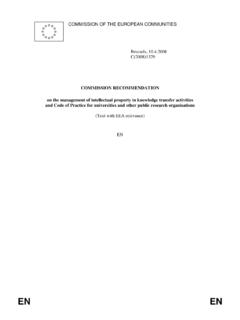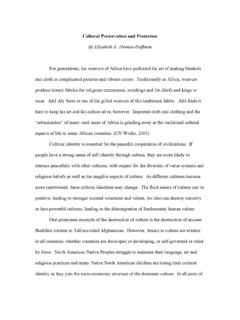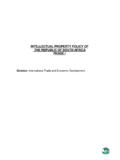Transcription of The Economics of Intellectual Property: A Review to ...
1 The Economics of Intellectual property : A Review to Identify Themes for Future Research Padraig Dixon* and Christine Greenhalgh**. November 2002. * Nuffield College, Oxford ** Oxford Intellectual property Research Centre St. Peter's College, Oxford Acknowledgements: The second author was invited to write this paper by the Intellectual property Advisory Committee (IPAC) of the UK Patent Office. She is grateful to the Director of the Intellectual property Institute, Paul Leonard, who provided a small grant to employ Padraig Dixon, who drafted much of the eventual text. We also acknowledge the assistance of Dr. Mark Rogers, Harris Manchester College, in respect of the literature on competition and innovation.
2 P Dixon and C A Greenhalgh, 2002. 1. Table of Contents 1 4. Introduction to the 4. The tradeoff between incentives and monopoly .. 4. Preview .. 5. 2 Determinants of innovation and acquisition of IP rights -The Schumpeterian issues of market structure and 6. 6. Innovation, Intellectual property and Market Structure: Theory and Evidence .. 7. Competition Policy and Intellectual property Rights .. 11. Introduction .. 11. The Issues .. 12. 3 The Valuation of Intellectual property Rights .. 15. 15. Approaches to Valuing IPR .. 17. The Costs Approach .. 17. Econometric Evaluation of IPR 20. Productivity Approaches .. 20. Profit, Market Value and IPR.
3 222. Wages, Employment and IPR .. 25. 4 The Costs of Enforcing Intellectual property 27. 27. Measuring the costs of IPR infringement .. 27. The costs to consumers, producers, and 28. Enforcement 29. 5 Science and Society .. 30. 30. Facts about innovative activity .. 30. The origins of technological innovation .. 31. Incentives for scientists engaged in pure research .. 31. Private and public incentives for R&D .. 32. Public policy, and the three players .. 32. University-industry links .. 32. Government and R&D .. 35. 2. 6 Domestic Policies to promote IP and its adoption .. 37. 37. Alternative Systems to Promote Innovation .. 37. The Reward 37.
4 Kremer on Vaccines and Auctions .. 39. Other proposals .. 40. Tax Credits for R&D .. 41. 7 43. 43. What is TRIPS? .. 44. What does TRIPS mean for the global economy? .. 45. TRIPS and Macroeconomic Activity .. 46. Contentious Aspects of TRIPS .. 49. Enforcement Aspect of 50. Intellectual property Rights and 51. 8 Questions for Future 52. Bibliography .. 55. 3. 1 Introduction Introduction to the Review This paper reviews the literature on the Economics of Intellectual property rights. Intellectual property rights (IPR) refer to the legal protection accorded to certain inventions or creations of the mind, and certain features of IPR are of particular interest to economists.
5 This section introduces the main issues that arise when studying economic aspects of IPR. The trade-off between incentives and monopoly An important part of analysing Intellectual property involves characterising the rivalrous nature of goods (see Paul Romer, 2002). A nonrival good is one that can be used simultaneously by many people; its use by one application does not make it harder for other people to use the same nonrival good. An example of a nonrival good would be a mathematical theorem. Goods that are rival cannot be used simultaneously by more than one person (David Romer, 1996)1. An example of a rival good would be a set of clothes being worn at a particular time: only one individual can successfully wear a particular piece of clothing at that instant.
6 Since the cost of reproducing a nonrival good, once the good has been discovered, is zero, the marginal cost of such a good is zero. Elementary Economics tells us that resources are allocated efficiently when prices are equated to marginal costs. If a positive price is charged, then the price of a nonrival good is above zero, so there is loss of efficiency. If a zero price is all that is possible, the development is not motivated by a desire for profit. However, nonrival goods can sometimes be made excludable: a good is said to be excludable if it is possible to prevent it use by others. Acquiring an IPR for a particular creation of knowledge is an example of making a nonrival good excludable.
7 Economists are particularly interested in this feature of IPR. Economists and others have long argued that strong property rights applied to rival goods result in efficient outcomes. Strong property rights, such as IPR, for nonrival goods involve a trade-off. Since a nonrival good by definition can be used by many people at once, it is clear that the creators of a nonrival good must either not care about profit, being motivated by other incentives, or the good will not be produced or marketed. Weak property rights for nonrival goods will result in a level of provision below the socially efficient level (Paul Romer, 2002). Agents that undertake research in the expectation of earning profits will not be willing to take on the risks and costs of such activity, since any rewards from doing so will evaporate due to imitation almost as soon as the creation is marketed.
8 To give people an incentive to produce socially desirable new innovations, IPR allow the creators of a nonrival good to appropriate the returns of their innovation for themselves alone. But since IPR make a nonrival good excludable, it constitutes an inefficiency, 1. Some of what follows is based on David Romer (1996). 4. since the price of the good will be above the marginal cost of producing the good. In other words, granting an IPR to an entity is tantamount to conferring a monopoly. Economists are then left to adjudicate as to the desirability of using IPR as a spur to innovation, and as an instigator of monopolistic inefficiency. This trade-off between encouraging innovation and suffering the consequences of monopoly was noted by many writers and was formally analysed in a modern way by Nordhaus (1969).
9 What are the monopoly costs of strong property rights for IPR?2 A monopolistic firm sells its produce at a monopolistic price, and earns monopolistic profits. For a monopoly resulting from the holding of an IPR, this results in suboptimal incentives to commit resources to investment, since monopoly profits are less than the overall benefit to society. In other words, a rational monopolist will only invest in an amount of research that will earn it the monopoly profit, and such behaviour will not achieve the maximal benefit to society that would obtain if production were undertaken in a competitive market. Consumers lose because monopolists restrict output to boost price, and therefore lose out by not enough of the monopoly good being sold (see Shavell and Ypersele, 2001).
10 Understanding whether these monopoly costs of IPR are less than the benefit to society emanating from the spur IPR give to innovation constitutes the motivation of the economic study of IPR, and provides the major theme of this Review . Even where economic analysis cannot provide final answers, many of the works reviewed here offer partial contributions to this over-arching theme. Preview In the next section, we consider the origin of Intellectual property and its relation to overall economic activity. This section discusses the relationship between Intellectual property creation, firm size, and market structure. The topical and complex issue of the relationship between antitrust policy and Intellectual property policy is also reviewed.






